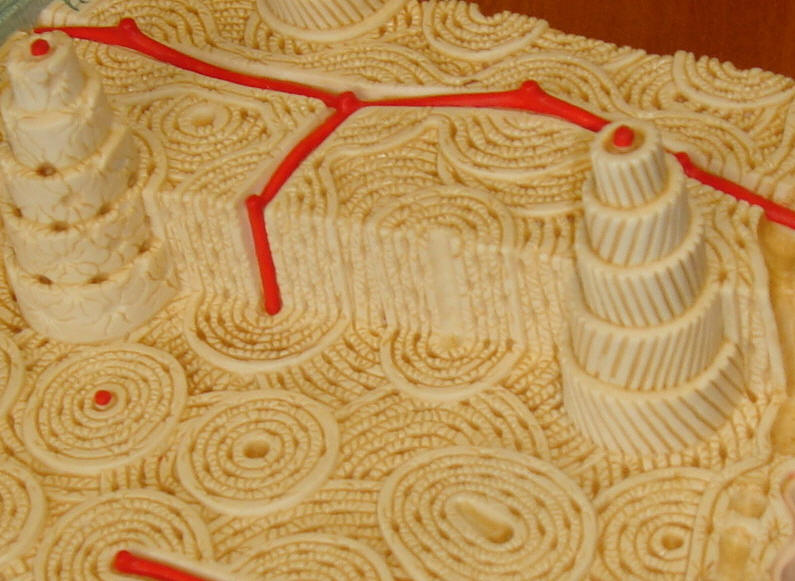|
SiNuPrOs:
Simulations
Numériques
des
Propriétés
de l’Os
|
 |
SiNuPrOs is a model of the human
cortical bone that takes into accounts the architectural, multiphysics and multi
scale aspects of this medium. We have built this model in which bony
architecture is organized in a hierarchical way, each level contributing to the
overall properties. The present modelization of the cortical bone leans on
previous studies (J.M. Crolet,
B. Aoubiza, S. Dasser, N. Pernin, R. Mahraoui, ...) but this one is
more complete because it takes into account firstly many parameters characterizing the
complex architecture of cortical bone which were ignored before and secondly the
interaction fluid-structure and evolving behaviors law.
This model contains five architectural levels, 28 parameters and provides
detailed information at each level of the bony architecture, including micro and nano levels.
Mathematical homogenization theory is used as a modelization tool and finite
element analysis is used for computing the mechanical properties of the
cortical bone at each architectural level.
Many
configurations can be tested, covering a large number of possible situations and
allowing comparative analyses between macroscopic and microscopic properties.
Bony
architecture
Human cortical
bone can be considered as a composite medium, the fibbers being the osteons
embedded in the interstitial system (IS) i.e. a medium made of surmineralized
osteons which have been destroyed during the remodelling phase. The most
important entities are the mineralization and the osteon, which, by its tubular
geometry, is characterized by a diameter and a porosity. The channels called Haversian channels are oriented according to the longitudinal direction and are
linked by Volkmann channels located in transverse plans. The following
parameters have to be considered: distance between two osteons, distance between
an osteon and the IS (i.e. the thickness of the cement line), distance between two Volkmann
channels and the Volkmann porosity.
The osteon is not
homogeneous. Being composed by concentric lamellae encased one in the
others, it is parameterized by the lamellar and interlamellar thicknesses. These
lamellae are crossed by small channels (canaliculae) and this canalicular volume
is taken into account simultaneously for the current osteon and the IS.
The nonhomogeneous
lamella is considered as a composite, the fibers (the collagen fibers which one
considers as cylinders) being embedded in a medium made of hydroxyapatite (Hap)
crystals and fluid. Then it is necessary to introduce the cylinder diameter, the
distance between two such cylinders and their orientation according the
longitudinal axis.
Concerning the
mineralization, an abstract entity, (the Elementary Volume of Mineral Content or
EVMC) has been introduced; it is made of a particular set of Hap crystals. This
EVMC has no physiological reality but it represents a typical elementary volume
of the crystalline structure. The associated parameters
are the percentages of EVMC and linked water respectively in the current osteon
and in the IS. A coefficient of nanoscopic anisotropy is added.
According to this
description, the SiNuPrOs model contains 18 structural parameters, distributed
as following: 6 for the Haversian system, 4 for the osteon, 3 for the lamellar
architecture and 5 for the mineral structure. All the physical properties (10
parameters) have to be added: density of collagen and Hap, Young's moduli of
collagen and Hap, Poisson's ratios of collagen and Hap, piezoelectric and
dielectric tensors of collagen, dielectric tensors for the EVMC and the fluid.
This geometrical and architectural description makes the SiNuPrOs model
particularly complete.
The
present model has been implemented in Matlab and the basic cells
discretization has been made with Modulef. The data used by the SiNuPrOs model
determine the architectural composition at each level and in a second step,
several techniques of homogenization are applied in order to determine the
physical properties at each level. The inputs of SiNuPrOs are only the mechanical
properties of basic components (collagen and Hap crystals) and a given
architecture (described by the parameters mentioned above). The outputs are the
physical properties at each level of the architecture.
So, its main interest is the
evaluation of physical properties at each level, for a given configuration. It
can also be used to seek, by successive tests, configurations corresponding to
already measured properties.
The calculation time being
relatively long, from 10 minutes for a mono-architecture to 45 minutes for
architectures with 3 or 4 types of osteons, the research of such a
configuration could take hours. This point is not neglectable knowing that many
experimental values can be found in the literature but none give any information
on the architectural characteristics of the studied sample. For this reason we
have built a fast version of this software (SiNuPrOs-Fast) based on a database
of results and on the approximation techniques.
The results are instantaneously
obtained and that's why the Fast version is extremely convenient. The researched
configuration being thus obtained, it has then to be validated by the original
version. The main interest of such a Fast version is the research of a possible
architectural configuration for a sample whose the elastic diagonal properties
have been experimentally measured.
|
 |
 |
|
The software is
written in Matlab 6 (R12).
1) After the
downloading of the zip file, you can get all the procedures in a folder called "Sinupros
6.0".
2) Execute Matlab
and in the current directory windows of Matlab search the folder "Sinupros
6.0".
3) Execute
SiNuPrOs by writing "run" in the command window of Matlab.
|
SiNuPrOs Fast is
based on the Excel component of Microsoft Office.
It contains several files.
1) After the
downloading of the zip file, you can get all these files in a folder called "Sinupros
Fast 6.1 ".
2) Open
simultaneously all these files and update them.
3) The windows
contains all the files and
shows as first page the data file called "Sinupros Fast.xls".
4) See the

|
Home DMA
Contact
|